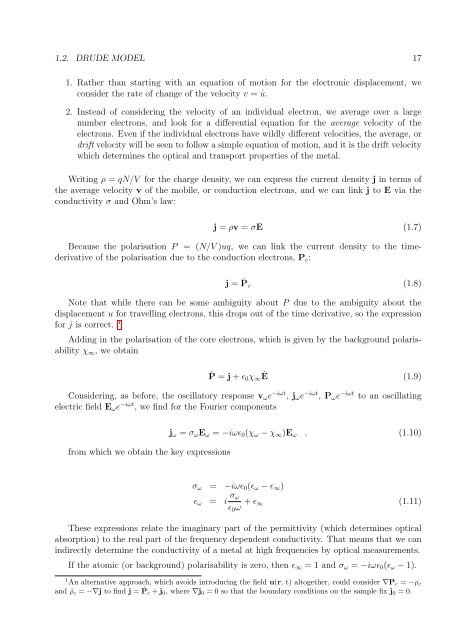Set of supplementary notes.
Set of supplementary notes.
Set of supplementary notes.
Create successful ePaper yourself
Turn your PDF publications into a flip-book with our unique Google optimized e-Paper software.
1.2. DRUDE MODEL 17<br />
1. Rather than starting with an equation <strong>of</strong> motion for the electronic displacement, we<br />
consider the rate <strong>of</strong> change <strong>of</strong> the velocity v = ˙u.<br />
2. Instead <strong>of</strong> considering the velocity <strong>of</strong> an individual electron, we average over a large<br />
number electrons, and look for a differential equation for the average velocity <strong>of</strong> the<br />
electrons. Even if the individual electrons have wildly different velocities, the average, or<br />
drift velocity will be seen to follow a simple equation <strong>of</strong> motion, and it is the drift velocity<br />
which determines the optical and transport properties <strong>of</strong> the metal.<br />
Writing ρ = qN/V for the charge density, we can express the current density j in terms <strong>of</strong><br />
the average velocity v <strong>of</strong> the mobile, or conduction electrons, and we can link j to E via the<br />
conductivity σ and Ohm’s law:<br />
j = ρv = σE (1.7)<br />
Because the polarisation P = (N/V )uq, we can link the current density to the timederivative<br />
<strong>of</strong> the polarisation due to the conduction electrons, P c :<br />
j = Ṗc (1.8)<br />
Note that while there can be some ambiguity about P due to the ambiguity about the<br />
displacement u for travelling electrons, this drops out <strong>of</strong> the time derivative, so the expression<br />
for j is correct. 1<br />
Adding in the polarisation <strong>of</strong> the core electrons, which is given by the background polarisability<br />
χ ∞ , we obtain<br />
Ṗ = j + ɛ 0 χ ∞ Ė (1.9)<br />
Considering, as before, the oscillatory response v ω e −iωt , j ω e −iωt , P ω e −iωt to an oscillating<br />
electric field E ω e −iωt , we find for the Fourier components<br />
from which we obtain the key expressions<br />
j ω = σ ω E ω = −iωɛ 0 (χ ω − χ ∞ )E ω , (1.10)<br />
σ ω = −iωɛ 0 (ɛ ω − ɛ ∞ )<br />
ɛ ω = i σ ω<br />
ɛ 0 ω + ɛ ∞ (1.11)<br />
These expressions relate the imaginary part <strong>of</strong> the permittivity (which determines optical<br />
absorption) to the real part <strong>of</strong> the frequency dependent conductivity. That means that we can<br />
indirectly determine the conductivity <strong>of</strong> a metal at high frequencies by optical measurements.<br />
If the atomic (or background) polarisability is zero, then ɛ ∞ = 1 and σ ω = −iωɛ 0 (ɛ ω − 1).<br />
1 An alternative approach, which avoids introducing the field u(r, t) altogether, could consider ∇P c = −ρ c<br />
and ˙ρ c = −∇j to find j = Ṗc + j 0 , where ∇j 0 = 0 so that the boundary conditions on the sample fix j 0 = 0.








